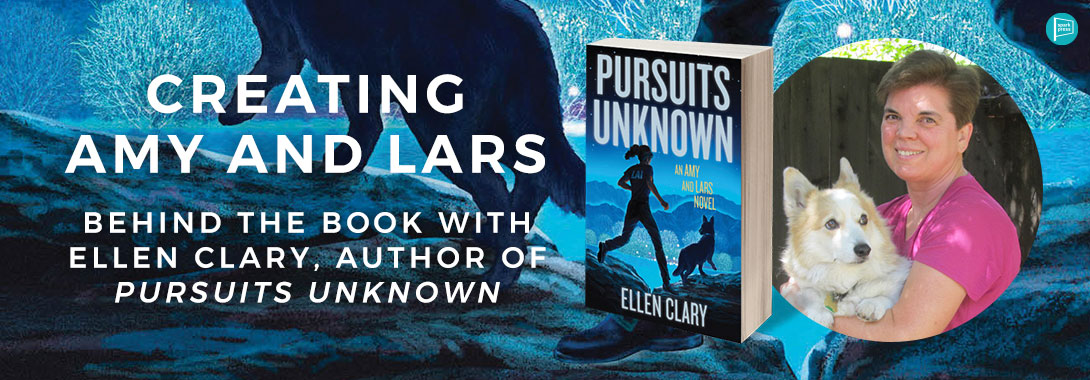
For years, I hoped that someone would write a story where the dogs were an integral part of the story, but not necessarily the focus of it. One that was dramatic, without the dog being the all-knowing sage. More where they were more like, well, dogs.
Once it finally became clear to me that some magical author wasn’t going to drop from the sky and write what I wanted to read, I finally decided to create the series myself. When my friend Jan dared me to participate in 2012’s NaNoWriMo (National Novel Writing Month), I decided that it was time to get started.
Within a few weeks, I realized that I could not keep up with the frenetic pace that NaNoWriMo requires, but I continued to write, albeit at a slower pace. I could write five hundred words a day, and if you do that, writing does happen and a novel may even materialize. (Okay, it’s not quite that easy, but it was a good start.)
Once I committed to telling the stories, it became a game of “What if?” What if some dogs could communicate with their owners? What would that look like? I decided that it would be much more interesting to notgive them superpowers beyond basic telepathy, and to have their intelligence be equivalent to what a typical working dog is—around the level of a human toddler.
Then it became a question of what do the dogs say telepathically? It starts off very basic in which humans will spend a lot of time teaching dogs useful words. With this in mind, the teaching of a workable set of words quickly became the backdrop to the whole book series, and it gives my inner dog behavior geek a constructive outlet.
After deciding to write in the world of science fiction, I was free to invent whatever jobs for the dogs I wished. Their owners are a highly fictionalized team of Locate And Investigative police liaison agents. Creating conflict within the character’s job is a nice way to build tension from a story’s premise. For example, they love search and rescue, but they have to do the detective work; they have to see the darker side of humanity.
The main thing to keep in mind about world building and writing a series is that once you decide on the foundation, you have to stick with it. Readers will forgive a lot of things, but they need the world’s rules to be consistent, or it’s not fun to read. In my world, if a dog suddenly started reciting Shakespeare, that just would not work. It is not “believable” according to the expectations that had been established in the preceding pages. The suspension of disbelief would be broken into tiny unrecognizable pieces.
Readers want to be absorbed in your world, but in order for them to fully suspend disbelief and place trust in you, you must have a foundation or at least create a world that feels real. If they start out walking on the ground with gravity and living in a three-dimensional world, then that’s where you have to remain unless that’s a fundamental issue of your story.
Your characters should be relatively consistent as well, unless a major change is a part of the story. While your characters may grow as they deal with whatever circumstances you hurl their way, their basic behaviors should be on an even keel, unless you’re planning on them to just lose it and start throwing chairs.
If you plan the sudden behavior changes, it increases the impact. If they are consistently one way and then suddenly change, it increases the dramatic tension. However, it has to be a believable transition.
There are many aspects of a fictional world that you may address. You will have to pick some to shape your world.
Examples are:
- System of government
- Is there war or peace? Does the average person know how to fight or use a weapon?
- Religion: Do they have one, two, three, or many religions. Do they get along?
- Banking: Is there a money system you have to think about?
- How do people shop? Do they have credit cards or other methods?
- Technology
- Education system
- Mass Communication: How do people get news?
- Social tensions: Are their class differences? Rich and poor? Racism? Any other basis on which there may be discrimination or tension?
- Relationships: Are they monogamous? Polyamorous? Asexual?
- What do families look like?
- Do they have animals? What kind? What is their relationship to them?
- Healthcare: How do they treat their elderly? What is their healthcare like? What diseases are prevalent?
- Magic: Is there magic? What are its limits? Are there other supernatural things?
For Amy and Lars, I chose a world similar to ours, with more advanced technology and science. The cars and planes can drive themselves, though the driver can drive it manually. This makes staying informed on current technological advances vital, so any new inventions seem realistic or plausible in a near future. Some other things I invented simply because they were handy to have in-world, like a gadget that can store smells.
When building my world, I made everyone mixed race and decided sexuality was a non-issue. Interestingly, both race and sexuality come up, but the perspective of the characters completely changes the narrative in really interesting ways.
I also made the religions mostly polytheistic, with a few monotheistic religions thrown in to add to the tension. I took it upon myself to study a range of religions so that I could include a group of people holding values that are different from other groups. This granted me with some perspective to create an unsettling religious leader who is fundamentally scary, yet bright enough to pretend to care about his people to try to get his smaller world plan started—the fundamental conflict in Pursuits Unknown.

Leave A Comment